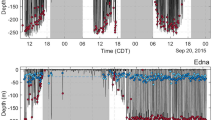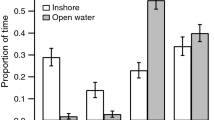Abstract
Twenty-four Mediterranean fin whales were tracked in open sea with a method based on the assessment of the animal differential position in respect of the observer's absolute position aboard a vessel, with the concomitant recording of the respiratory activity. Short distance video recording was also performed in two whales, permitting the simultaneous determination of single breath expiratory (T E) and inspiratory (T I) durations. In the 24 whales swimming at an average velocity of 1.39 (0.47) m·s−1 [mean (SD), range: 0.62–2.44 m·s−1], 2068 breaths organized in 477 respiratory cycles were observed. Each cycle entailed a prolonged apnoea dive phase [225 (91) s, T dive) followed by a period near the surface [62 (28) s, surfacing], during which a series of breaths [4.6 (1.8)] was performed at short intervals. On the basis of track length and swimming velocity, two groups of animals were devised differing for convolution of the course (p<0.001), extension of ranging territory (p<0.01) and horizontal swimming velocity (p<0.05), which may represent two distinct behaviours. A possibly general mechanism of control of breathing in cetaceans was found, consistent with a model of constant tidal volume and variable respiratory frequency. Coherently with this model, T E was independent of T I or T dive, in line with a passive expiration, while T I appeared to be negatively correlated with T dive (p<0.05), otherwise suggesting, similarly with terrestrial mammals, a significant role of hypercapnic stimulation. The estimated O2 consumption of about 150 l·min−1 is in line with the general allometric regression for mammals and corresponds to an energetic expenditure of 85–95 kJ·kg−1·day−1.








Similar content being viewed by others
References
Acevedo-Gutiérrez A, Croll DA, Tershy BR (2002) High feeding costs limit dive time in the largest whales. J Exp Biol 205:1747–1753
Bérubé M, Aguilar A, Dendanto D, Larsen F, Notarbartolo di Sciara G, Sears R, Sigurjonson J, Urban Ramirez J, Palsbøll PJ (1998) Population genetic structure of Northern Atlantic, Mediterranean Sea and Sea of Cortez fin whales, Balaenoptera physalus (Linnaeus 1758): analysis of mitochondrial and nuclear loci. Mol Ecol 7:585–599
Blix AS, Folkow P (1995) Daily energetic expenditure in free living minke whales. Acta Physiol Scand 153:61–66
Brody S (1968) Bioenergetics and growth. Haffner, New York, p 1023
Butler PJ, Jones DR (1997) Physiology of diving of birds and mammals. Physiol Rev 77:837–899
Clark FJ, von Euler C (1972) On the regulation of depth and rate of breathing. J Physiol (Lond) 222:267–295
Dolphin WF (1987) Ventilation and dive patterns of humpback whales, Megaptera novaeangliae, on their Alaskan feeding grounds. Can J Zool 65:83–90
Dorsey EM, Richardson WJ, Würsig B (1989) Factors affecting surfacing, respiration, and dive behaviour of bowhead whales, Balaena mysticetus, summering in the Beauford Sea. Can J Zool 67:1801–1815
Forcada J, Aguilar A, Hammond P, Pastor X, Aguilar R (1993) Distribution and abundance of fin whales in the western Mediterranean during the summer. Proceedings of the 7th Annual Conference of the European Cetacean Society, Inverness, UK, pp 128–130
Gambell R (1985) Fin whale. In: Ridgeway SH, Harrison H (eds) Handbook of marine mammals, vol 3. The sirenians and baleen whales. Academic, London, pp 171–192
Henke KG, Sharratt M, Pegelow D, Dempsey JA (1988) Regulation of end-expiratory lung volume during exercise. J Appl Physiol 64:135–146
Hertel H (1966) Structure, form, movement. Reinhold, New York
Irving L, Scholander PF, Grinnell SW (1941) The respiration of the porpoise, Tursiops truncatus. J Cell Comp Physiol 18:145–168
Jahoda M, Almirante C, Azzellino A, Panigada S, Zanardelli M, Canese S (1999) 3D tracking as a tool for studying behavior in Mediterranean fin whales (Balaenoptera physalus). Thirteenth Biennial Conference on the Biology of Marine Mammals. Wailea, Maui
Kanwisher J, Sundnes G (1965) Physiology of a small cetacean. Hvalrådets Skrifter 48:45–53
Kay JDS, Strange Petersen E, Vejby-Christensen H (1975) Mean and breath-by-breath pattern of breathing in man during steady-state exercise. J Physiol (Lond) 251:657–669
Kooyman GL, Sinnett EE (1979) Mechanical properties of the harbor porpoise lung, Phocoena phocoena. Respir Physiol 36:287–300
Kooyman GL, Norris KS, Gentry RL (1975) Spout of the gray whale: its physical characteristics. Science 190:908–910
Lafortuna CL, Reinach E, Saibene F (1996) The effect of locomotor-respiratory coupling on the pattern of breathing in horses. J Physiol (Lond) 492:587–596
Leith DE (1976) Comparative mammalian respiratory mechanics. Physiologist 19:485–510
Leith DE (1983) Comparative mammalian respiratory mechanics. Am Rev Respir Dis 128:S77–S82
Leith D, Lowe R (1972) Mechanics of baleen whale lungs. Fed Proc 31:335A
Lockyer C (1981) Growth and energy budgets of large baleen whales from the Southern hemisphere. In: Mammals in the sea, vol 3. Food and Agriculture Organization of the United Nations, Rome, pp 379–487
Nicol S (1986) Shape, size and density of daytime surface swarms of the euphausiid Meganyctiphanes norvegica in the Bay of Fundy. J Plankton Res 8:29–39
Notarbartolo di Sciara G, Zanardelli M, Jahoda M, Panigada S, Airoldi S (2003) The fin whale Balaenoptera physalus (L. 1758) in the Mediterranean Sea. Mammal Rev 33:105–150
Olsen CR, Elsner R, Hale FC, Kenney DW (1969) "Blow" of the pilot whale. Science 163:953–955
Ridgeway SH, Scronce BL, Kanwisher J (1969) Respiration and deep diving in the bottlenose porpoise. Science 166:1651–1654
Scholander PF (1940) Experimental investigation on the respiratory function in diving mammals and birds. Norske Videnskaps-Academy Oslo 22:1–131
Shaffer SA, Costa DP, Williams TM, Ridgeway SH (1997) Diving and swimming performance of white whale, Delphinapterus leucas: an assessment of plasma lactate and blood gases levels and respiratory rates. J Exp Biol 200:3091–3099
Stone GS, Katona SK, Mainwaring A, Allen JM, Corbett HD (1992) Respiration and surfacing rates of fin whale (Balaenoptera physalus) observed from a lighthouse tower. Rep Int Whal Commun 42:739–745
Sumich JL (1983) Swimming velocities, breathing patterns, and estimated cost of locomotion in migrating gray whales, Eschrichtius robustus. Can J Zool 61:647–652
Taylor CR, Maloiy GMO, Weibel ER, Langman VA, Kamau JMZ, Seeherman HJ, Heglund NC (1981) Design of the mammalian respiratory system. III. Scaling maximum aerobic capacity to body mass: wild and domestic mammals. Respir Physiol 44:25–37
Viale D (1985) Cetaceans in the Northwestern Mediterranean: their place in the ecosystem. Oceanogr Mar Biol Annu Rev 23:491–571
Wahrenbrock EA, Maruschak GF, Elsner R, Kenney DW (1974) Respiration and metabolism in two baleen whale calves. Marine Fish Rev 36:3–8
Williams TM, Friedl WA, Fong ML, Yamada RM, Sedivy P, Haun JE (1992) Travel at low energetic cost by swimming and wave-riding bottlenose dolphins. Nature 355:821–823
Williams TM, Friedl WA, Haun JE (1993) The physiology of bottlenose dolphins (Tursiops truncatus): heart rate, metabolic rate and plasma lactate concentration during exercise. J Exp Biol 179:31–46
Williams TM, Haun JE, Friedl WA (1999) The diving physiology of the bottlenose dolphins (Tursiops truncatus) I. Balancing the demands of exercise for energy conservation at depth. J Exp Biol 202:2739–2748
Würsig B, Dorsey EM, Fraker MA, Payne RG, Richardson WJ, Wells RS (1984) Behavior of bowhead whales, Balaena mysticetus, summering in the Beauford Sea: surfacing, respiration, and dive characteristics. Can J Zool 62:1910–1921
Würsig B, Wells RS, Croll DA (1986) Behavior of gray whales near St. Lawrence Island, Bering Sea. Can J Zool 64:611–621
Zanardelli M, Panigada S, Airoldi S, Borsani JF, Jahoda M, Lauriano G, Notarbartolo di Sciara G (1999) Site fidelity, seasonal residence and sex ratio of fin whales (Balaenoptera physalus) in the Ligurian Sea feeding grounds. Eur Res Cet 12:124
Zepelin H, Rechtschaffen A (1974) Mammalian sleep, longevity and energy metabolism. Brain Behav Evol 10:425–470
Acknowledgements
We are indebted to Captain Vincenzo Lubrano and the crew of the oceanographic ship "Urania" for their invaluable support and assistance at sea. We wish to thank Giuseppe Notarbartolo di Sciara, the biologists, the skippers of the Tethys Research Institute and all the students who passionately volunteered aboard the "Gemini Lab". We also thank Carla Almirante for software support and Laura Bonomi for collaborating in data collection aboard "Urania".
Author information
Authors and Affiliations
Corresponding author
Additional information
Partially presented as a poster at The World Marine Mammal Science Conference and 12th Annual Conference of the European Cetacean Society, Monaco (Montecarlo), 20–24 January 1998.
Angelo Colombini provided technical assistance.
Appendix
Appendix
The net distance covered by the whale (W t(0–1)) and its average swimming velocity (v t(0–1)) during the time interval (t (0–1)) of two consecutive measurements was calculated on the basis of the simultaneous determination of the ship's position in metric coordinates (by means of a GPS device) and of the whale distance (d) and azimuth (α) relative to the ship [by means of a compass integrated RADAR device or of a Laser Range Finder (LRF) binoculars], as it is also graphically expressed in Fig. 9. Thus, assuming a negligible stream:
Diagrammatic geometrical representation of the elements used by an observer situated on ship (S) for two consecutive determinations of whale (W) position (at time t 0 and t 1), based on whale distance (d) and azimuth (α). See Appendix for further details
where WΔlatt(0–1) and WΔlongt(0–1) represent the metric difference in whale latitude and longitude, respectively, and occurred in the interval t (0–1). Alternatively, these differences can be expressed as:
where SΔlatt(0–1) and SΔlongt(0–1) are the metric variation of ship latitude and longitude, respectively, which occurred in the time interval t (0–1) and are calculated from GPS data, while SWΔlatt(0), SWΔlongt(0), SWΔlatt(1), and SWΔlongt(1) represent the difference in latitude and longitude between the ship and the whale at the time t (0) and t (1), respectively. Furthermore, at the time n of any measurement, the difference in latitude and longitude between the ship and the whale is given by:
Whale average swimming velocity during the interval t (0–1) of two measurements was thus determined as:
Since the height of the observers above the water surface was negligible in comparison with the distance of the animals, it was not taken into account in the algorithm.
Rights and permissions
About this article
Cite this article
Lafortuna, C.L., Jahoda, M., Azzellino, A. et al. Locomotor behaviours and respiratory pattern of the Mediterranean fin whale (Balaenoptera physalus). Eur J Appl Physiol 90, 387–395 (2003). https://doi.org/10.1007/s00421-003-0887-2
Accepted:
Published:
Issue Date:
DOI: https://doi.org/10.1007/s00421-003-0887-2





